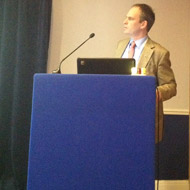Globalisation increases risk of emerging disease spread

Gareth Hateley said that Schmallenberg virus (SBV) is no longer a notifiable disease.
Lottie Bell, from the Roslin Institute, reminded delegates that 'bleeding calf syndrome' or bovine neonatal pancytopenia (BNP) was first reported in the UK in 2009 having emerged in continental Europe in 2007.
She explained that a strong epidemiological association between BNP and administration of a particular inactivated bovine viral diarrhoea vaccine (Pregsure) to the dams of affected calves has been reported. Studies suggest that BNP is mediated by the transfer of alloantibodies in colostrum, and these alloantibodies recognise major histocompatibility complex (MHC) class I molecules – the major tissue-type antigens that mediate graft rejection.
The ingestion of these alloantibodies by newborn calves via the colostrum causes rapid destruction of peripheral blood and bone marrow cells, resulting in the dramatic haemorrhagic signs seen in clinical cases. Colostrum from BNP-affected cows will induce the condition in unaffected calves and there is also a subclinical form of BNP in 15% of clinically normal calves.
The speaker suggested that it is important to handle BNP-affected calves gently in order to avoid exacerbating haemorrhage; long acting antibiotic therapy is a sensible precautionary measure; but that blood transfusion can be beneficial provided that administration is carried out with great care.
In addition, pooling of colostrum on affected farms should be avoided and consideration should be given to breeding from a different bull. The only certain solution is to cull cows that are known to have given birth to BNP-affected calves.
The second speaker, Gareth Hateley, from the APHA VI Centre in Thirsk, said that Schmallenberg virus (SBV) is no longer a notifiable disease and that this may lead to a degree of under-reporting, with the consequent risk that farmers and their advisers might underestimate the risk of re-infection in enzootic areas.
He reminded delegates of the congenital malformations seen in SBV-affected calves, of its spread via different Culicoides midges and that it was not zoonotic. Overwintering of the virus is possible via the vector and one bite is sufficient to transmit the disease.
Susceptible species include cattle, sheep and goats (camelids seroconvert) and infected animals show viraemia within two to five days of being bitten. The teratogenic effects develop in utero between days 60 - 150 of infection.
It is a disease of acute onset and generally low incidence in cattle – there was one outbreak in March this year in the south west of the UK – but occasionally high infectivity in sheep (up to 30% has been reported). Immunity may last for two years and vaccination is effective. Gareth told delegates that an effective vaccine had been produced rapidly by the pharmaceutical industry and "we should be mindful of the maxim 'use it or lose it'".
In conclusion, he suggested that other similar vector-borne diseases were just over the horizon, including Rift Valley Fever, West Nile Virus Fever and new strains of bluetongue virus; and that climate change and globalisation were constantly enhancing the risk.



 The RCVS has announced a new version of its 1CPD mobile app, with enhanced features for veterinary surgeons and veterinary nurses to record their continuing professional development.
The RCVS has announced a new version of its 1CPD mobile app, with enhanced features for veterinary surgeons and veterinary nurses to record their continuing professional development.